

Project «Voices of Jewish settlements. Vitebsk region.»פיתוח קשרי התרבות בין העמים של ישראל ובלרוס
|
|---|
Website search |
|
MainNew publicationsContactsSite mapVitebsk regionMogilev regionMinsk regionOLD BY THE WITNESSES OF THE TRAGEDY…Marat Gorevoy
|
TOLD BY THE WITNESSES OF THE TRAGEDY…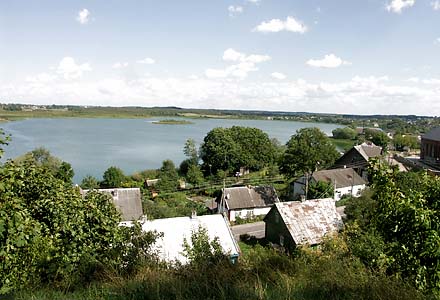 Braslav. Location of the ghetto. Photo taken in 2008.
Braslav. Location of the ghetto. Photo taken in 2008.
The war… These years are farther and farther away from us, but the pain from the loss is still strong. Death, starvation, torture became the fate of millions. The fate of Jews was especially tragic. 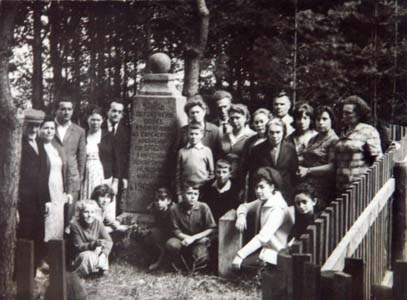 By the memorial to Braslav Jews who died
By the memorial to Braslav Jews who diedin the Holocaust. Photo taken in the 60’s. Below are extracts from the stories of those, who experienced the tragic events. On June 22nd, 1941 the people of Braslav found out about the beginning of the war. This day, remembers H. Band, there was a meeting near Lake Drivyaty, where representatives of the local authorities were assuring people that the enemy would be stopped and defeated, that there was no need to flee or hide. And the locals did want to believe that. The two days that followed they were observing the progress of the Red Army in the west. However the picture changed soon. The troops, together with locals, started retreating eastward. M. Milutin, a witness, narrates about Germans coming to the town: - On the fourth day of the war, which was Thursday, German military men came to town on motorcycles. They looked around for a while and left. At night German troops, tanks and artillery passed through the town. In Braslav they left a small garrison, which immediately started the atrocities. 
The following day all Jews were gathered on the trade square. Men, women and children were separated and taken to a swampy part of the lake near a village called Dubki. They were kept there the whole night, and that night, when trying to escape, several people were shot – Sh. Reznik, Zitsber and my cousin H. Milutin. He was later taken to the cemetery by his uncle R. Milutin, who told us there had been 17 gunshot wounds on the body. The rest of the people spent one more night on that swamp, expecting the worst. However that time they escaped an execution: unexpectedly everyone was allowed to come back to town on Saturday. And here another trouble was waiting for them: ravaged houses. Then came the first orders: Jews had to wear yellow tabs on clothes: on the chest and the back. 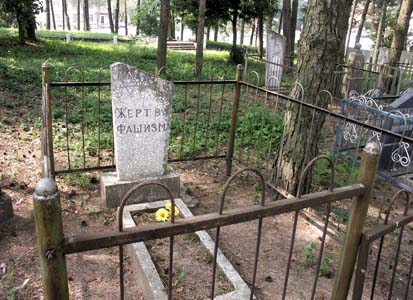 Memorial to Bralsav Jews who died in the Holocaust.
Memorial to Bralsav Jews who died in the Holocaust.Photo taken in 2008. Jews were prohibited to walk on the pavement, visit a cinema, a theater or any other public place. Every Jewish house had to have an inscription «Jude». Later they were deprived of fur clothes, felt boots, other warm things, cattle and poultry. They were also forced to do physical work. One such group of 13 «workmen» was shot. There were many other groups like that… 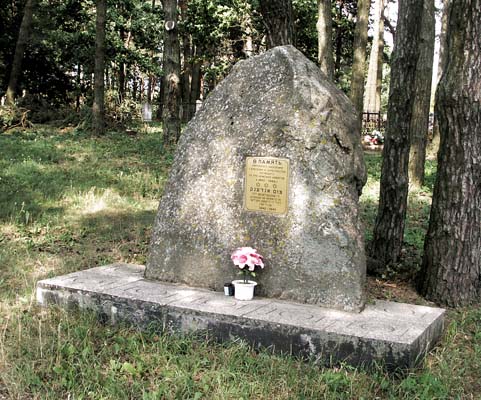 Memorial to Bralsav Jews who died in the Holocaust.
Memorial to Bralsav Jews who died in the Holocaust.Photo taken in 2008. On July 19th, 1941 Germans surrounded village Dubina. Four Jews were shot at once. The rest were pushed into a synagogue. The men were ordered to lie on the floor; then they were kicked and hit with sticks. After that 20 people were chosen and shot at a cemetery. 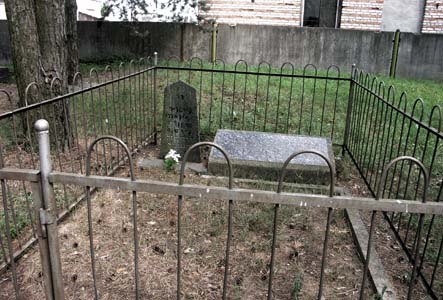 Memorial to Bralsav Jews who died in the Holocaust.
Memorial to Bralsav Jews who died in the Holocaust.Photo taken in 2008. At the beginning of April another order came from Gestapo: «All the Braslav Jews are to move to the houses in Pilsudski Street (now Leninskaya street).» This was location of the new ghetto. People were crammed into the houses, there was no medical help. It was the beginning of the end – the physical extermination of Jews. One a Tuesday, before the slaughter, Germans ordered to send a hundred women to clean a barrack in Slobodka. The following day they were brought back to town and shot. On June 3rd, 1942 the ghetto was awakened by the sound of shooting and shouting of drunken murderers. They were breaking windows, doors and ordering everyone to come out. Liuba Byk witnesses: «Our house was at the beginning of the ghetto. At midnight we heard heavy footsteps. Two policemen broke into the house and started hitting us. The daughter was killed in her bed, sister Rosa with her two children was shot near the fence. We were taken to the local Jewish school. M. Boron was killed on the way.» 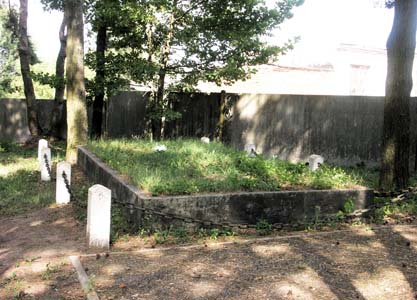 Mass grave of Opsa ghetto victims. Photo taken in 2008.
Mass grave of Opsa ghetto victims. Photo taken in 2008.
People were pushed to specially prepared ditches, where they were made to undress and shot. Many fell into the ditches while still alive. Several days after the execution one could still see the ground move. The mass murders lasted three days, very few people survived. Before the Jewish New year Germans created another ghetto in Opsov. It did not exist long, either - on March, 19th, 1943 its prisoners were executed. The article is based on materials, provided by Braslav history museum. |
|||
|
|
Jewish settlements in Vitebsk regionVitebsk • Albrehtovo • Babinovichi • Baran • Bayevo • Begoml • Beshenkovichi • Bocheikovo • Bogushevsk • Borkovichi • Braslav • Bychiha • Chashniki • Disna • Dobromysli • Dokshitsy • Druya • Dubrovno • Glubokoye • Gorodok • Kamen • Kohanovo • Kolyshki • Kopys • Krasnopolie • Kublichi • Lepel • Liady • Liozno • Lukoml • Luzhki • Lyntupy • Miory • Obol • Oboltsy • Orsha • Osintorf • Ostrovno • Parafianovo • Plissa • Polotsk • Prozorki • Senno • Sharkovshina • Shumilino • Sirotino • Slaveni• Smolyany • Surazh • Tolochin • Ulla • Verhnedvinsk • Vidzy • Volyntsy • Yanovichi • Yezerishe • Zhary • Ziabki • |
|||
Main |
New publications |
Contacts |
Site map |
Vitebsk region |
Mogilev region |
Minsk region |